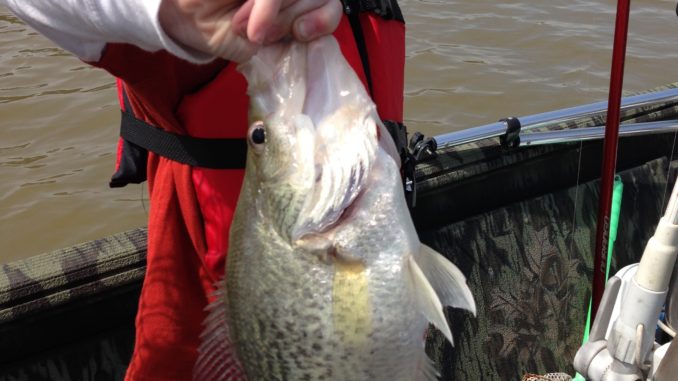
Troll to find concentrations of nice slabs
Niorwood’s David Diggs fishes year-round for crappie at Lake Tillery, and he knows that March rates as a prime month for catching large slabs at the Yadkin River impoundment.
To locate fish, Diggs sets out as many as 16 to 18 Southern Crappie poles, ranging from 8 to 16 feet in length, mounted on the front, back and sides of his boat.
“You can catch 12- to 13-inch crappie all day, and an occasional 16-inch fish once you find them,” he said.
In early March, with water temperatures in the 40s and 50s, Diggs looks for fish holding over points, drops and creek contours.
He mounts eight poles in the bow of his boat using downlines with 1-ounce weights. Each features a double rig with 1/16-ounce jigs tipped with minnows. They cover the water column from 4 to 12 feet.
In the stern, he has four poles with unweighted long lines with double rigs also holding 1/16-ounce jigs tipped with minnows. He sets out two planer boards on each side of his boat that employ crankbaits running 6 to 8 feet deep, and he keeps a spinning rod rigged with a Little Cleo spoon for casting when warm days push the fish close to the bank.
“I troll at 1.5 mph or less and try to maintain the same speed, because increases or decreases in speed affect the depths of my baits,” said Diggs. “After I catch a few fish at a certain depth, I adjust my spread to make other baits run at that depth.”
His spinning reels are filled with 6-pound fluorocarbon line because of the line’s transparency.
In clear water, Diggs selects jigs in John Deere green, chartreuse, and lemon; in dark water, he uses dark colors like dark blue.
“All of my jigs have a touch of chartreuse somewhere,” he said.
Despite the potential for snagging with so many lines in play, Diggs fishes around brush piles.
“Locals have planted brush piles in 20 to 25 feet of water that extend up about 10 feet,” he said. “I carefully troll around the edges of the brush and catch crappie that way. If I get too close, I pay for it with broken lines and lost jigs.”
Diggs trolls the Jacobs Creek and Steel Bridge areas or wherever sea gulls are present, though unstable weather can move the fish about. Rising barometric pressure slows the bite.
“Once the water temperature reaches the mid-60s in late March, the shallow crappie bite turns on,” said Diggs. “Just cast crappie jigs at any shallow cover and retrieve slowly.”




Be the first to comment